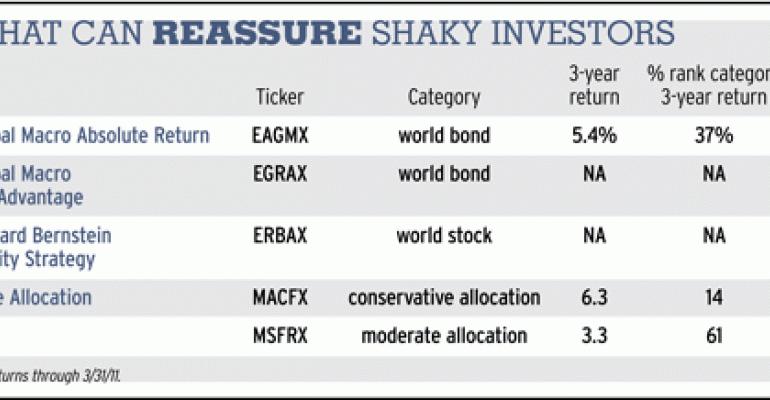Advisors don’t appreciate how cautious clients have become, said speakers at the Investment Company Institute’s recent general membership meeting in Washington yesterday. Despite two years of rising markets, clients continue to hold big amounts of cash. Among the most cautious investors are young people aged 25 to 35, said Sallie Krawcheck, president of global wealth and investment management for Bank of America/Merrill Lynch. “For this generation, investing has been a colossal disappointment,” she said.
Young people saw equity markets collapse a decade ago, and in more recent years they witnessed the housing crash, said Martin Beaulieu, vice chairman of MFS Investment Management. That has left young investors wary of investments of all kinds. “Their overwhelming emphasis is on preserving capital,” he said, speaking in an interview with Registered Rep. at the Washington meeting.
A study by MFS found that advisors don’t fully understand the mood of clients. While 72 percent of advisors said that equities are sound investments, only 35 percent of investors agreed. Advisors in the survey estimated that young people had half their assets in stocks, but the investors said that they had only 34 percent in equities.
To reach nervous investors, some advisors should consider balanced funds and other funds that include diversified mixes of stocks and bonds, said Beaulieu of MFS. Traditional balanced funds hold a cautious mix that includes 60 percent of assets in blue-chip stocks and 40 percent in high-quality bonds. Many advisors shun the traditional balanced funds, figuring that they are stodgy and inflexible. But Beaulieu argues that balanced funds are ideal choices today because they tend to provide stable results in erratic markets.
He said that many companies have abandoned balanced funds, focusing on narrow choices specializing in a single style box. All too often investors have used the narrow funds improperly, buying aggressive growth funds when they were hot and selling in downturns. “Funds companies have done a lot of slicing and dicing to come up with specialized funds, and fund investors have not always been well served by that,” said Beaulieu.
Instead of taking only specialized funds, advisors should recommend some balanced funds that rebalance regularly, Beaulieu said. Because of the rebalancing, the funds produced relatively strong results in recent years. During the downturn of 2008, the funds rebalanced, selling strong-performing bonds and buying unloved stocks. That helped boost returns when markets recovered.

Beaulieu cites MFS Total Return (MSFRX) as an example of a balanced fund that is ideal for cautious clients. The fund keeps 60 percent of assets in undervalued blue chips and the rest in Treasuries and other high-quality bonds. About every quarter, the fund rebalances. During the ten years ending in March, the fund returned 4.8 percent annually, outdoing the S&P 500 by more than a percentage point and surpassing 74 percent of its moderate allocation peers, according to Morningstar. The fund has excelled in downturns, outpacing the benchmark by wide margins during the downturns of 2000 and 2008.
For the most cautious clients, a stable choice is MFS Conservative Allocation (MACFX), which has returned 5.9 percent annually, outdoing 91 percent of conservative allocation funds. The fund keeps about 60 percent of assets in fixed income. Instead of holding individual securities, the portfolio manager holds a portfolio of MFS funds.
Beaulieu says that some advisors are becoming more interested in traditional balanced funds or funds of funds. He said that many advisors from Edward Jones have been emphasizing funds of funds and other balanced choices. “These funds are good choices for investors with $100,000 to invest,” he said.
Another way to reach wary investors is by using funds that have freedom to range around the globe, said Jac McLean, head of retail distribution for Eaton Vance. Because they were not forced to stay in a single style box, some go-anywhere funds shifted to cash or used other techniques to limit losses in 2008. “These funds offer risk management and diversification,” said McLean, speaking in an interview at the ICI membership meeting.
A go-anywhere choice is Eaton Vance Global Macro Absolute Return (EAGMX). The fund was among the strong performers in 2008, returning 1.7 percent for the year and outdoing 66 percent of peers in the world bond category. The fund can buy bonds and currencies anywhere in the world, and the portfolio managers can take long or short positions. After enjoying strong inflows, the fund gathered more than $2 billion in assets and recently closed to new investors. To serve new investors, the company recently opened Eaton Vance Global Macro Absolute Return Advantage (EGRAX). Both funds have the same managers and follow similar approaches.
Another wide-ranging choice is Eaton Vance Richard Bernstein Multi-Market Equity Strategy (ERBAX). The new fund is run by Richard Bernstein, who gained a reputation for savvy market calls while serving as Merrill Lynch’s investment strategist. During the late 1990s, Bernstein told clients to avoid expensive technology stocks and emphasize energy and mining stocks. That was a contrarian call that proved on target. These days Bernstein is avoiding emerging markets because the stocks are too expensive. Instead, he is emphasizing small U.S. stocks, which have been reporting strong earnings gains.
Bernstein continues to have a loyal following among Merrill Lynch advisors. Since the fund opened in October, it has attracted $450 million in assets. Half the money is from Merrill Lynch advisors, says McLean of Eaton Vance.


